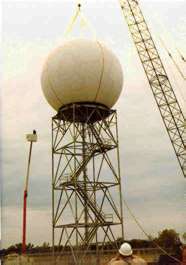 |
|||||||
There is a lot of hardware that is necessary for a radar to run, here is a brief look at some of the main components required to run a National Weather Service (NWS) WSR-88D NexRad radar.
The most seen component of a radar is the actual dome itself.
 Especially
with S band radars, see the bands section, a large
dome is needed. Since this dome can easily be over 30 feet in height and on
top of a tower over 100 feet in height, it can be visible from long distances.
The dome essentially just houses and protects the radar dish. It is made of
a material that allows the signal to leave through it and also return through
it. Inside that dome is the dish itself.
Especially
with S band radars, see the bands section, a large
dome is needed. Since this dome can easily be over 30 feet in height and on
top of a tower over 100 feet in height, it can be visible from long distances.
The dome essentially just houses and protects the radar dish. It is made of
a material that allows the signal to leave through it and also return through
it. Inside that dome is the dish itself.
 The
main purpose of the dish is to focus the transmitted power into a small beam
and also to listen and collect the returned signal. More information about
dish sizes can also be found in the bands section.
The
main purpose of the dish is to focus the transmitted power into a small beam
and also to listen and collect the returned signal. More information about
dish sizes can also be found in the bands section.
In a nutshell, that is essentially what a radar's dish does. That visible part is really just a small part of what actually makes the radar work. There are three components in a WSR-88D radar besides the dish and tower. These are the Radar Data Acquisition (RDA), the Radar Product Generator (RPG), and finally the Principal User Processor. (PUP)
RDA - The radar data acquisition unit is what houses the actual transmitter and the receiver. The transmitter sends out multiple pulses every second. Between those pulses, the receiver receives the reflected energy from the pulse. Since precipitation is moving and every return signal is different, it reads over 20 pulses per second and sends that data on to the RPG.
RPG - The radar product generator receives the information from the receiver. It takes the 20 or more pulses that the receiver received in one second and averages them together. After the RPG gets the information from one volume scan, or one rotation of the radar, it creates the products that we see on TV or the Internet. Some of these products are the reflectivity of the precipitation and also the velocities of the precipitation calculated using the Doppler Effect.
PUP - The principal user processor is the unit that allows for the interface with the radar. This has been in the past the only workstation that allowed a user to access the radar data and control the radar. Now, the NWS is installing AWIPS in all of their offices. This allows anyone in the building to access the radar data. This will aid in monitoring multiple storms and help get warnings issued more quickly.
The above images are courtesy McGill University
For questions or comments about this page, please visit our "Contact Us" page.
Created
by Adam Frederick, webmaster@severewx.com
Content and Images (unless otherwise noted) Copyright 1999 Adam Frederick
Last updated 07/22/99 11:17 AM